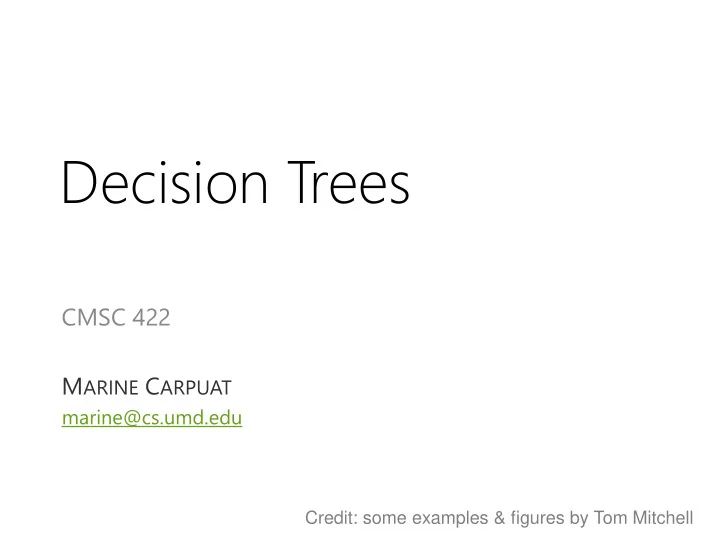

Decision Trees CMSC 422 M ARINE C ARPUAT marine@cs.umd.edu Credit: some examples & figures by Tom Mitchell
Last week: introducing machine learning What does it mean to “learn by example”? • Classification tasks • Learning requires examples + inductive bias • Generalization vs. memorization • Formalizing the learning problem – Function approximation – Learning as minimizing expected loss
Machine Learning as Function Approximation Problem setting • Set of possible instances 𝑌 • Unknown target function 𝑔: 𝑌 → 𝑍 • Set of function hypotheses 𝐼 = ℎ ℎ: 𝑌 → 𝑍} Input • Training examples { 𝑦 1 , 𝑧 1 , … 𝑦 𝑂 , 𝑧 𝑂 } of unknown target function 𝑔 Output • Hypothesis ℎ ∈ 𝐼 that best approximates target function 𝑔
T oday: Decision Trees • What is a decision tree? • How to learn a decision tree from data? • What is the inductive bias? • Generalization?
An example training set
A decision tree to decide whether to play tennis
Decision Trees • Representation – Each internal node tests a feature – Each branch corresponds to a feature value – Each leaf node assigns a classification • or a probability distribution over classifications • Decision trees represent functions that map examples in X to classes in Y
Exercise • How would you represent the following Boolean functions with decision trees? – AND – OR – XOR – 𝐵 ∩ 𝐶 ∪ (𝐷 ∩ ¬𝐸)
T oday: Decision Trees • What is a decision tree? • How to learn a decision tree from data? • What is the inductive bias? • Generalization?
Function Approximation with Decision Trees Problem setting • Set of possible instances 𝑌 – Each instance 𝑦 ∈ 𝑌 is a feature vector 𝑦 = [𝑦 1 , … , 𝑦 𝐸 ] • Unknown target function 𝑔: 𝑌 → 𝑍 – 𝑍 is discrete valued • Set of function hypotheses 𝐼 = ℎ ℎ: 𝑌 → 𝑍} – Each hypothesis ℎ is a decision tree Input • Training examples { 𝑦 1 , 𝑧 1 , … 𝑦 𝑂 , 𝑧 𝑂 } of unknown target function 𝑔 Output • Hypothesis ℎ ∈ 𝐼 that best approximates target function 𝑔
Decision Trees Learning • Finding the hypothesis ℎ ∈ 𝐼 – That minimizes training error – Or maximizes training accuracy • How? – 𝐼 is too large for exhaustive search! – We will use a heuristic search algorithm which • Picks questions to ask, in order • Such that classification accuracy is maximized
T op-down Induction of Decision Trees CurrentNode = Root DTtrain(examples for CurrentNode,features at CurrentNode): 1. Find F, the “best” decision feature for next node 2. For each value of F, create new descendant of node 3. Sort training examples to leaf nodes 4. If training examples perfectly classified Stop Else Recursively apply DTtrain over new leaf nodes
How to select the “best” feature? • A good feature is a feature that lets us make correct classification decision • One way to do this: – select features based on their classification accuracy • Let’s try it on the PlayTennis dataset
Let’s build a decision tree using features W, H, T
Partitioning examples according to Humidity feature
Partitioning examples: H = Normal
Partitioning examples: H = Normal and W = Strong
Another feature selection criterion: Entropy • Used in the ID3 algorithm [Quinlan, 1963] – pick feature with smallest entropy to split the examples at current iteration • Entropy measures impurity of a sample of examples
Sample Entropy
A decision tree to predict C-sections Negative examples are C-sections [833+,167-] .83+ .17- Fetal_Presentation = 1: [822+,116-] .88+ .12- | Previous_Csection = 0: [767+,81-] .90+ .10- | | Primiparous = 0: [399+,13-] .97+ .03- | | Primiparous = 1: [368+,68-] .84+ .16- | | | Fetal_Distress = 0: [334+,47-] .88+ .12- | | | | Birth_Weight < 3349: [201+,10.6-] .95+ .05- | | | | Birth_Weight >= 3349: [133+,36.4-] .78+ .22- | | | Fetal_Distress = 1: [34+,21-] .62+ .38- | Previous_Csection = 1: [55+,35-] .61+ .39- Fetal_Presentation = 2: [3+,29-] .11+ .89- Fetal_Presentation = 3: [8+,22-] .27+ .73-
A decision tree to distinguish homes in New York from homes in San Francisco http://www.r2d3.us/visual-intro-to-machine-learning-part-1/
T oday: Decision Trees • What is a decision tree? • How to learn a decision tree from data? • What is the inductive bias? • Generalization?
Inductive bias in decision tree learning CurrentNode = Root DTtrain(examples for CurrentNode,features at CurrentNode): 1. Find F, the “best” decision feature for next node 2. For each value of F, create new descendant of node 3. Sort training examples to leaf nodes 4. If training examples perfectly classified Stop Else Recursively apply DTtrain over new leaf nodes
Inductive bias in decision tree learning • Our learning algorithm performs heuristic search through space of decision trees • It stops at smallest acceptable tree • Why do we prefer small trees? – Occam’s razor: prefer the simplest hypothesis that fits the data
Recommend
More recommend